So, you want to learn to play Pickleball? Great! Let’s not do a bunch of talking with a heavy lead in. Let’s just jump right into it!
This Article
This article is broken down into 3 sections:
- A quick explanation of how to play Pickleball
- An in-depth explanation of how to play Pickleball
- Advanced content sections
1. A Quick Explanation of How to Play Pickleball
This quick explanation (click to skip to it) explains in bare bones what you need to know about Pickleball and will get you out there swinging the paddle knowing moderately what you are doing – read this section and stop if you want to get out there and playing in 10 minutes or less and are okay filling in the blanks later.
You could also watch our 2 minute explanation on how to play Pickleball here:
2. An In-Depth Explanation of How to Play Pickleball
This in-depth explanation (click to skip to it) will build on the information from the “Quick Explanation” and give you a bit more context and cover mostly everything you need to get started – read this section if you want the rules that will come up 85% of the time in Pickleball. Meant for players who are wanting to fill in most of the blanks and are okay with other Pickleballers they play with helping them fill in the other 15%.
3. Advanced Content Sections
These Advanced content sections are in the “In-Depth” version above, will have a green box around them and look like this:
These sections cover the last 15% mentioned above.
So, feel free to read as much, or as little, as you want and stop when you feel comfortable and ready to play Pickleball.
Let’s get started!
Quick Explanation – How to Play Pickleball
In a nutshell, Pickleball is a racquet sport with similar rules to tennis just on a much smaller court.
It’s played with a unique racquet called a Pickleball Paddle, with a unique ball called a Pickleball Ball (think wiffle ball but harder), and on a Pickleball Court which is a smaller version of a tennis court more or less.
Most players play doubles currently (2 people on one side of the court, 2 people on the other side of the court, 4 people playing total) which will be the focal point of this article.
Play starts with a serve diagonally across the court from the Serving Team to the Opposing Team.
Play continues until there is a fault by one of the 4 players. The most common faults are also very similar to tennis:
- Hitting the ball into the net or not getting the ball across the net
- Hitting the ball out of bounds
There are a few other faults that are rarer and unique to Pickleball which we’ll discuss more in the in depth articles but 90% of faults if not 95% happen from the 2 faults listed above.
Once someone faults, if the serving team won the rally then they are awarded a point. And then whoever served the last point on the Serving Team switches places with their partner and now serves diagonally to the other member of the Opposing Team.
If the Opposing Team (the non-serving team) won the rally, then the server loses their serving turn. The next person in line to serve will now serve. This is either the other player on the Serving Team if that player hasn’t served yet, or if that player has served, the Opposing Team now gets the ball to serve and the Opposing Team will start their serving turn with each player getting to serve until they lose the point and the serve will switch again.
A few more points on serving:
- Serving always starts with the player on the right
- The team that starts the game serving is only allowed to have one person serve. Once the team that starts loses a rally/point then the ball goes to the other team. They will now be able to have both players serve as normal and the game will continue this way. This is just to get the game started.
Play continues this way until one team scores 11, and you must win by 2.
And that’s pretty much Pickleball in a nutshell.
Confused? Want more detail?
Then read our in-depth explanation which is up next.
In-Depth Explanation – How to Play Pickleball
Okay, let’s get down and deep into Pickleball!
Equipment
Equipment is boring to talk about when you just want to get out there and play the game but for true beginners, you should probably know about it.
If you already know about the:
- Pickleball Court
- Ball
- Paddle
Then just skip below to how to play the game.
The Court
Pickleball is played on a court similar to a tennis court but the court is much smaller:
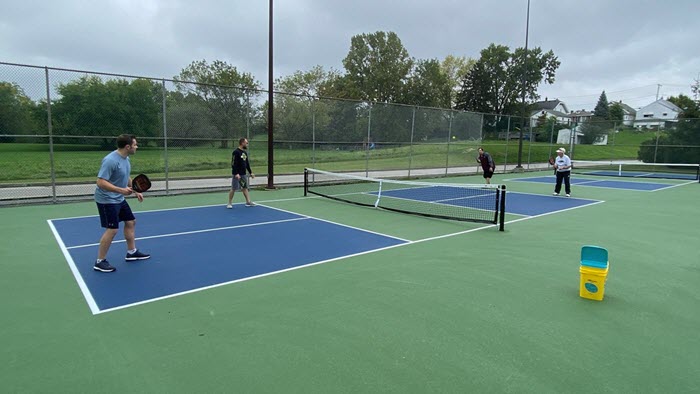
The court is also reversed a bit where the rectangles (Service Courts) are side by side in tennis are in the back and the solo rectangle is in the front. That solo rectangle is called the Kitchen and is one of the main differences between Pickleball and tennis, adding a whole new element of strategy.
The Ball
Pickleball is played with a ball called a pickleball that is very similar to a wiffle ball in size and with holes in.
But the pickleball is a little harder than a wiffle ball to improve speed and therefore, playability (no one wants to hit a weak whiffleball over and over, there needs to be some speed for difficulty).
The Paddle
The pickleball is hit with a racquet/paddle aptly named a Pickeball Paddle.
There are a bunch of different types of Pickleball paddles, some better than others. We’ll write a blog post on this in the future but for now, any paddle will do for you as a beginner. An Amazon paddle would work just fine and is a safer investment in case you play and don’t like the game. You might also just borrow a paddle from someone you know and play with. Many players have extras.
Paddles are made of different materials but they are relatively light and have a sweet spot in the middle, like a tennis racquet. The feeling of contact is relatively the same as with tennis. In the beginning don’t worry about that. It has a very natural feel when making contact with the ball.
They are also smaller than a tennis racquet but obviously bigger than a ping pong paddle.
Playing the Game
Okay, let’s get into what you really want, more Pickleball rules!
We’re going to break this down into the flow of a full rally or point. All the way from the serve to the end where someone faults and then a new point or rally starts.
And a game is honestly just a series of rally’s until one team scores 11 points and then that team wins.
So, if you understand what a rally/point is, you understand the full game of Pickleball.
Speaking of, let’s define a few terms quickly that will be used often in this article:
- Rally/Point – technically called a “Rally” but sometimes referred to as “the Point”, a Rally is just a series of back and forth shots that start with a serve and end in a fault. Once a fault occurs a new Rally begins with a new serve and once again ends in a fault and continues this way until the end of the game.
- Game – a series of Rally’s makes up an entire Game.
The Beginning of the Point/Rally (The Serve)
Start the point/rally by serving.
The Serve
One team will start the game serving.
Note: Which team serves first doesn’t really matter. Each place you play at will have different rules for which team starts and sometimes they are very arbitrary: like who is closest to the highest fence on the court (a local rule at one of our parks we play at for example). Again, it doesn’t really matter who starts, just ask whoever you are playing which side serves first if you’re playing regulars who play there often. Or if you’re with beginners just choose a team.
Once you have the team designated to serve first, the person on the right of that team will serve first (this is always true when one team is starting to serve and is also true when it’s time for the Opposing Team to start serving, something we’ll talk about more later).
Let’s show an example of this in real time:
Notice the person on the right served to start the rally/point.
We’ll simple call this person the “Server”.
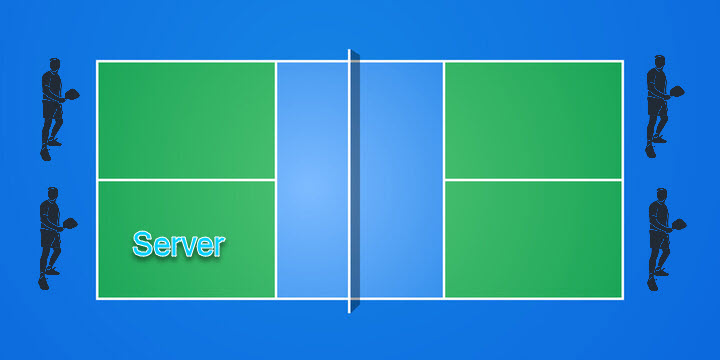
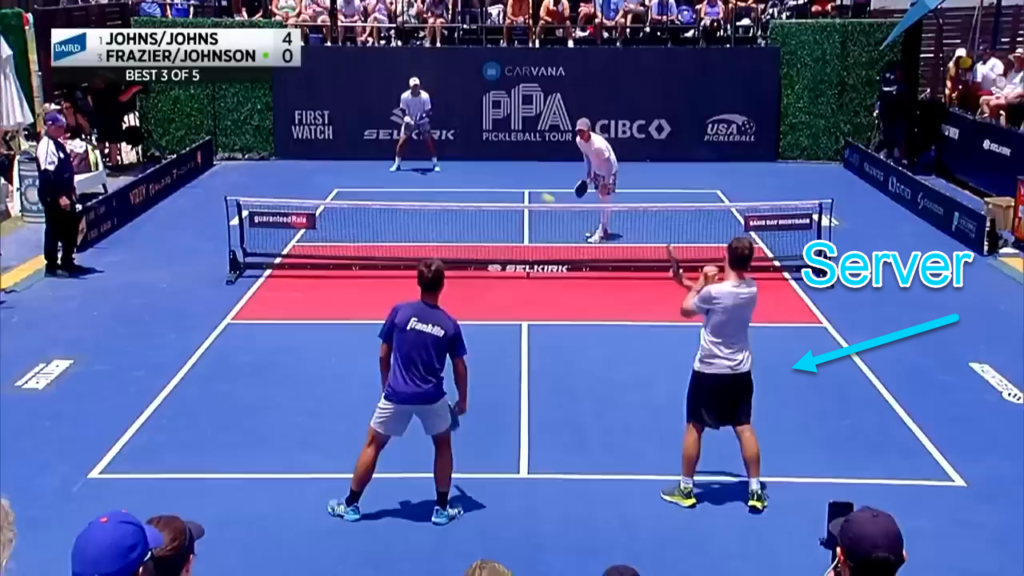
The Server will serve to the opposite team’s player diagonally from them which is the Returner’s service area (yellow square):
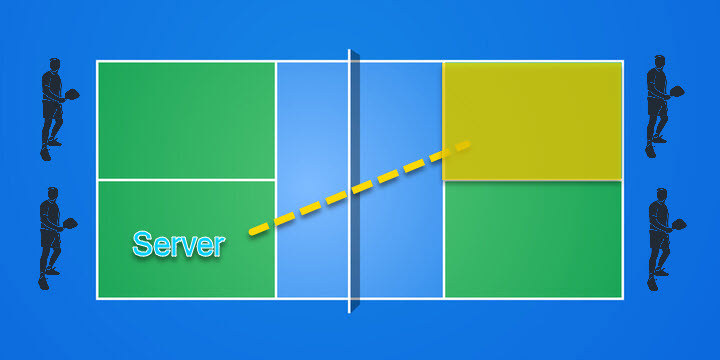
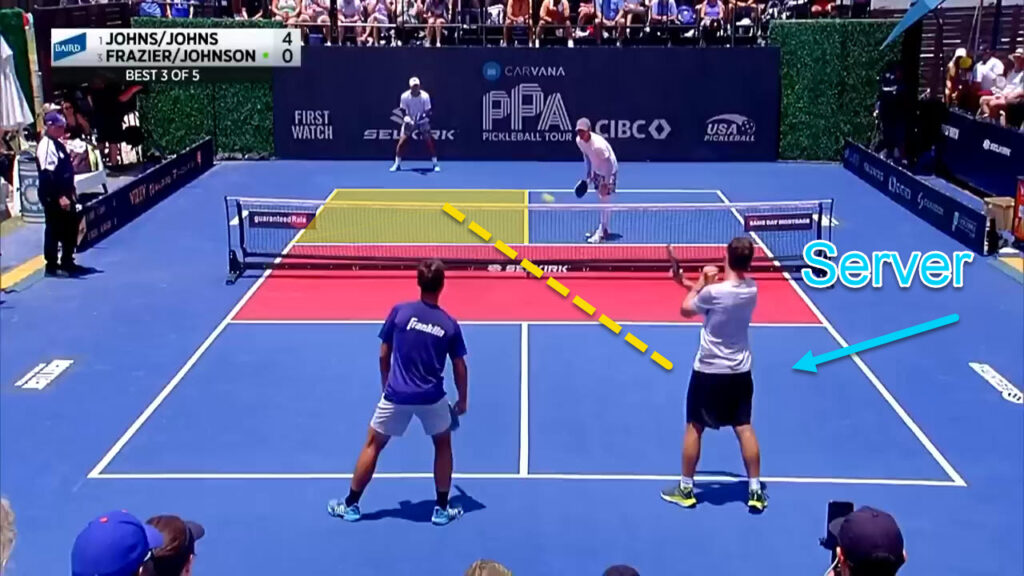
They will be the “Returner”:
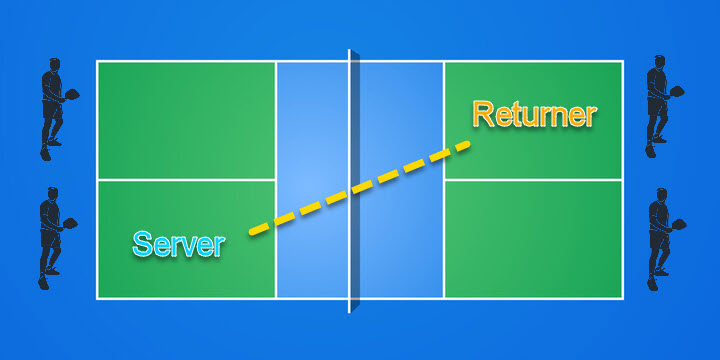
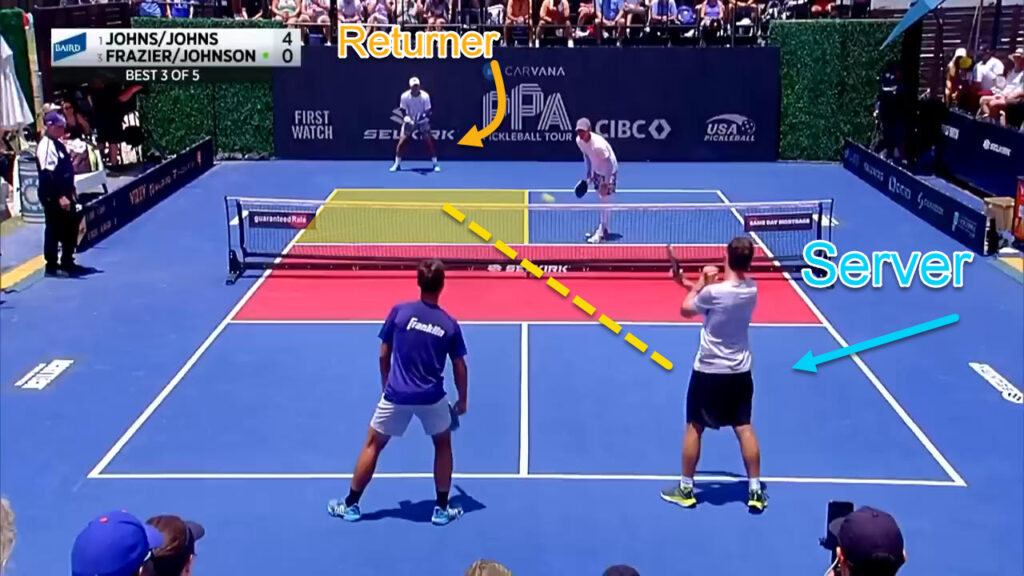
In Pickleball, like tennis, you will always serve diagonally.
When you serve, your Serve may:
- Land inside the opposite, diagonal Service Area of you:
- Land on the left, right, and back lines of the the opposite, diagonal Service Area of you:
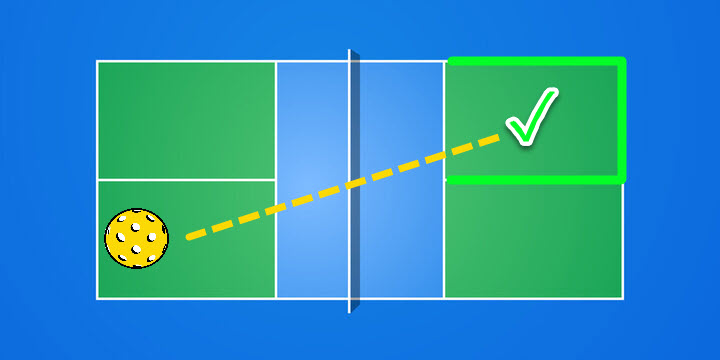
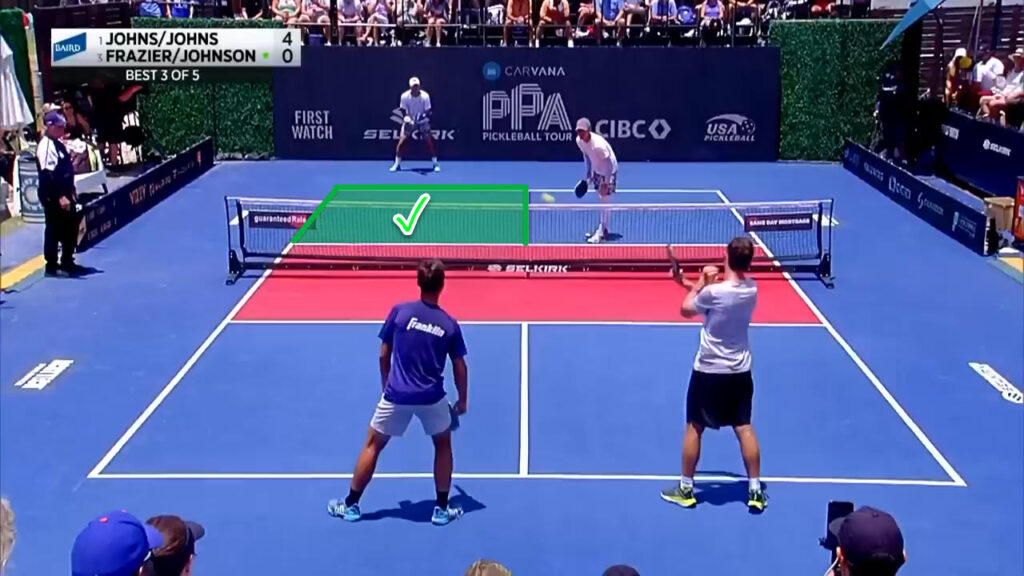
The Serve may NOT:
- Land in the opposite Kitchen:
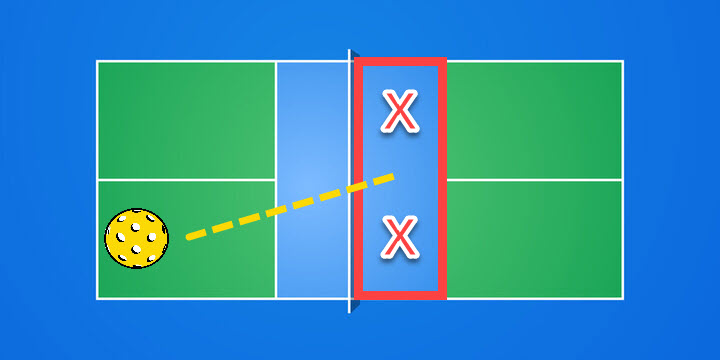
And a real game shot (with orange used instead of red to avoid confusion due to the Kitchen literally being colored red in real life on this particular court):
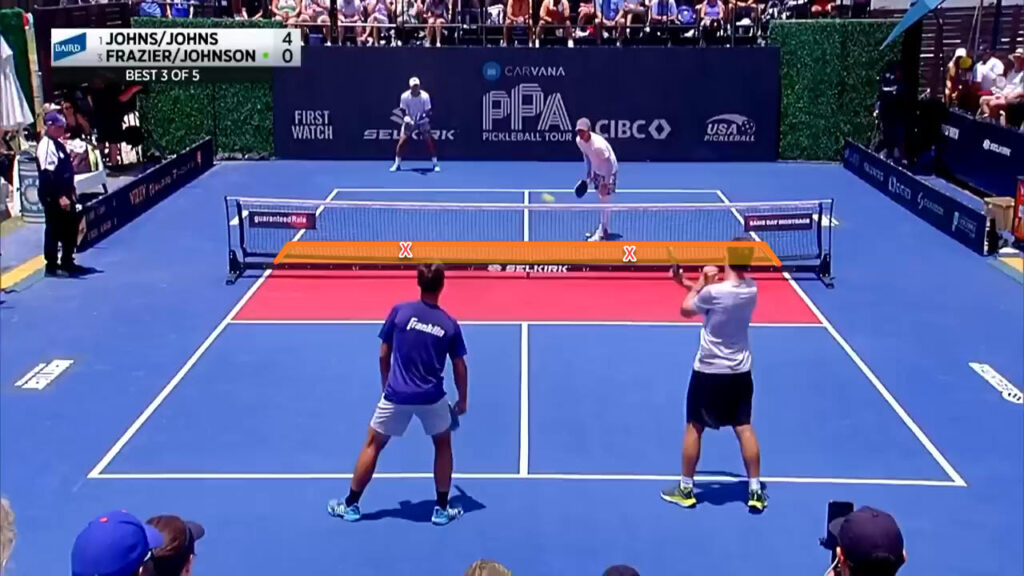
2. Land on the opposite Kitchen line:
Advanced: Pay special attention to this because it is a confusing rule. Players think all the time the Kitchen line is in on a serve. It is not.
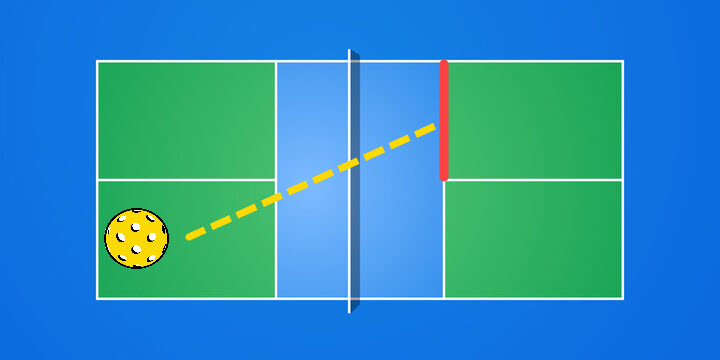
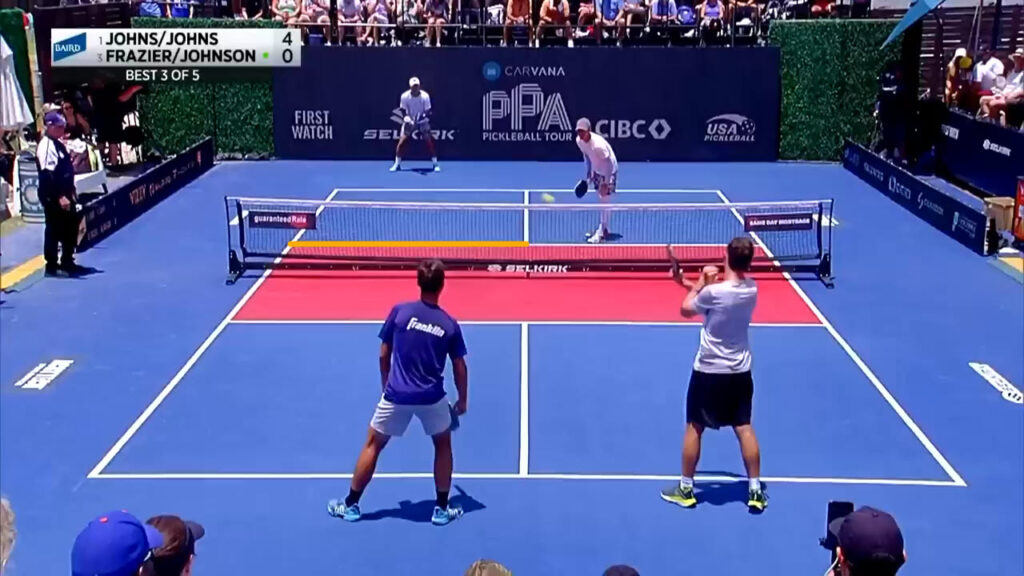
3. Land in the opposite Service Area of you:
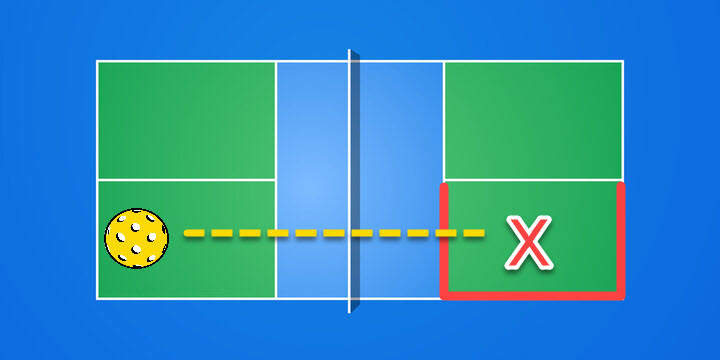
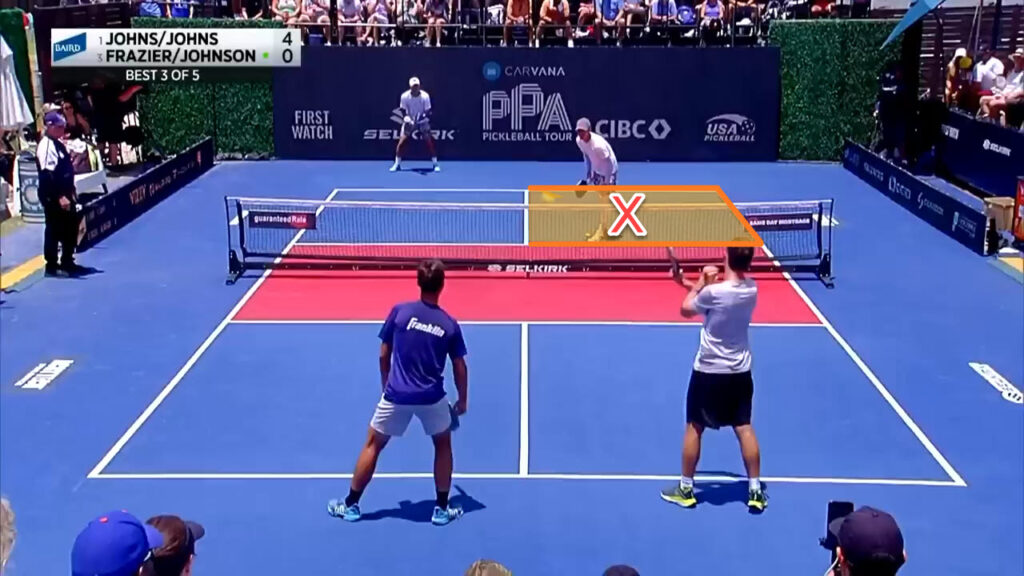
Here’s a full image of what the serve can and can’t do:

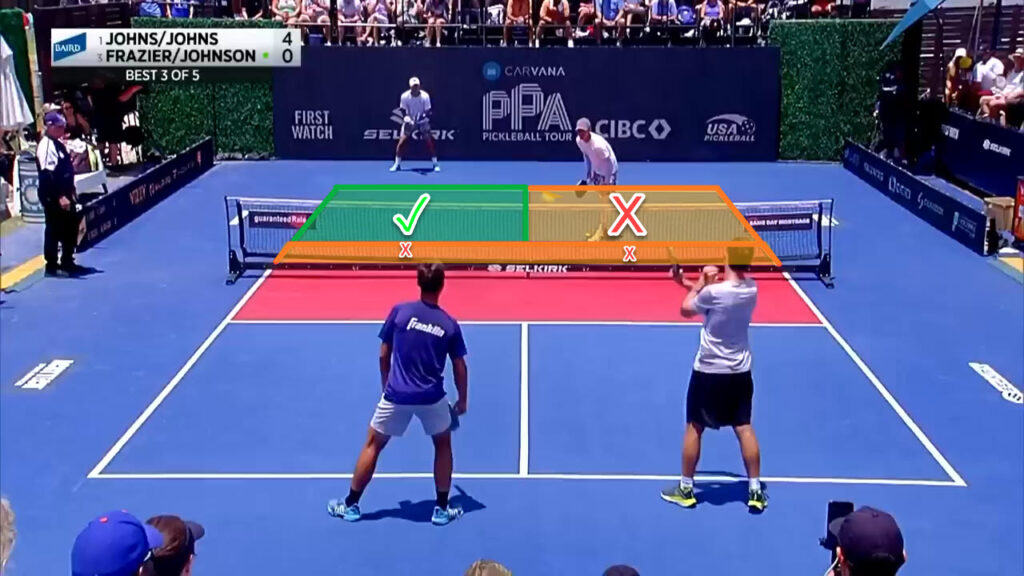
If the Serve lands anywhere in red (or orange in the Game Shot), it’s a fault.
If the Serve lands anywhere in the green, it’s a good serve.
Also, it goes without saying, if you serve out of bounds, it’s a fault.
Once the Server serves a successful Serve that is in the diagonal Returner’s Service Area, the Returner can now hit the ball to whichever person they want on the other team, no matter who it is. The only time you must hit to a certain person in Pickleball is on the serve, where the Server must serve to the opposing player diagonal from them:
Now it’s the Returner’s turn to hit the serve and again, they can hit it anywhere, as long as it’s across the net and in bounds of course:
And the point/rally continues this way until there is a fault.
Once a fault occurs, you collect the ball, give it to the next Server to serve (whether that’s the same Server or a new Server, more on this in a bit), and then another point/rally starts.
And that’s the basics of serving.
Alternating serves
In Pickleball, serves alternate after every point.
Here’s a quick breakdown on how alternating serves works:
Each person on a team gets to serve.
The person who serves first is First Serve and the person who serves second is Second Serve.
Once The First Serve loses the point/rally on their Serve, the Serve passes to their teammate, the Second Serve.
The Second Serve will serve until they lose a point/rally, at which point the Serve then goes to the Opposing Team.
The Opposing Team will follow the same pattern. The Opposing Team’s First Serve will serve until they lose the point/rally and then the Second Serve will serve.
Once the Second Serve loses a point/rally then they will give the ball back to the original team.
And serving continues to alternate this way, back and forth.
Advanced: Breakdown On Alternating Serve
When a rally/point is over the side that serves always changes. And it can change in one of two ways:
- The Serving Team won the point/rally and the same person will serve again.
- The Serving Team lost the point/rally and now a new person will serve.
the serving team won the point/rally
If the serving team won the point/rally then the Serving Team switches sides and the person who served last serves again. And they will continue to serve until the Serving Team loses a point/rally.
In this scenario, let’s say Ashlee served first:
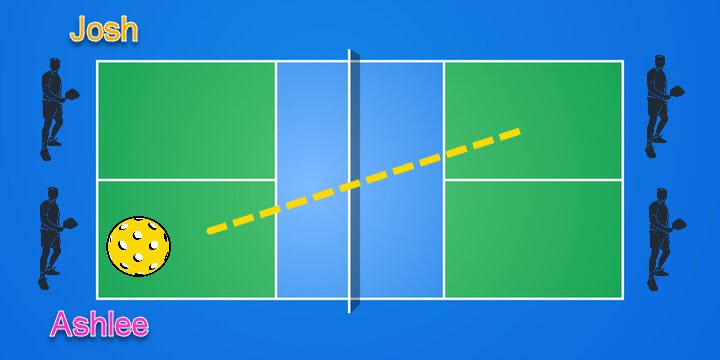
And the Serving Team (Josh & Ashlee) won the point/rally. Let’s say Ashlee slammed a ball into the opposing player’s court and they couldn’t hit it. Since they won the rally/point, and Ashlee served that point/rally, she and Josh will switch sides:
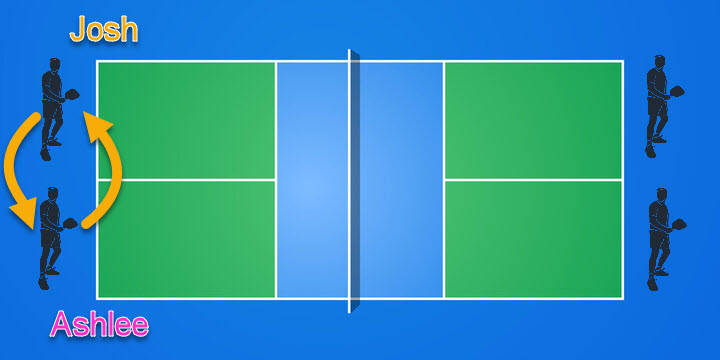
And Ashlee will serve again to the opposite, diagonal Service Area:
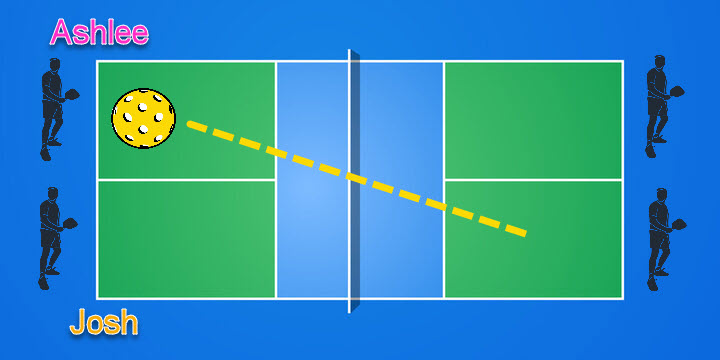
Here’s a real game example of the Serving Team winning the point and then serving from the other side:
Note: Don’t get thrown off by the team in all white (The Johns brothers) not technically “switching sides” after they win the point/rally. They’re doing something advanced called “Stacking” that gives them a positional advantage. No one stacks until upper level tournament play and 99% of recreational Pickleball is played switching sides, not stacking. So, you don’t need to worry about stacking right now. Just understand that in regular recreational Pickleball the Server would switch sides with their partner, instead of their partner standing to the side while the Server serves, like the Johns brothers are doing.
And the Server will keep switching, serving to the other diagonal Service Area as long as they win the rally/point.
The Serving Team lost the point/rally
So, now let’s say that the Serving Team lost the point/rally. It’s time to alternate who serves.
There are two possible scenarios here:
- If the Serving Team’s other player hasn’t served yet, they now serve.
- If the Serving Team’s other player has already served, the Opposing Team now serves.
In our example it would look like this:
- Here’s a clip where the Johns brothers lose the First Serve and alternate from the player who is First Serve to the player that is Second Serve:
2. Here’s a clip where the Johns brothers lose the Second Serve and then have to give the Serve to the Opposing Team:
And this will continue. The Opposing Team will serve until both players have served and then the serve will pass back to other team and that team will serve until both have served and it will pass back to the Opposing Team, etc. etc.
Advanced: Serving Positioning
Let’s talk about positioning on the serve.
The first thing we’ll talk about is positioning for the Server.
Positioning for the Server
When the Server serves, their foot may not contact the 1) court or the 2) court lines until after the ball is struck:
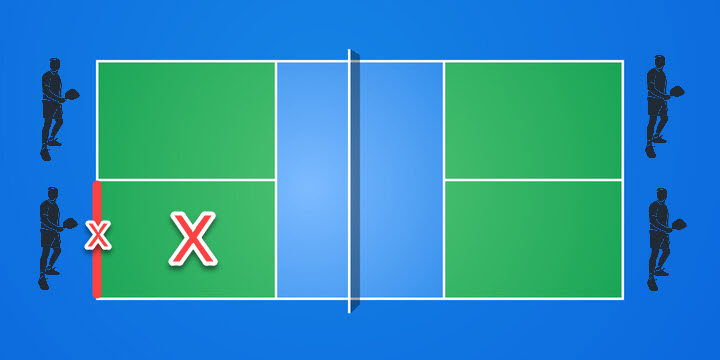
However, once the ball is served, the Server can step wherever they want.
Positioning for the Server’s Partner
The Server’s partner can actually be wherever they want but in terms of strategy, they should stay behind the line with their partner:
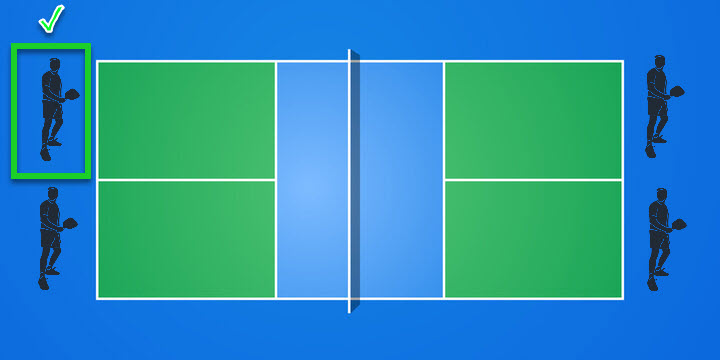
positioning for the “Returner”
The player on the Opposing Team that is being served is called the “Returner”. The Returner can also technically stand wherever they want. But strategically should also stand behind the line:
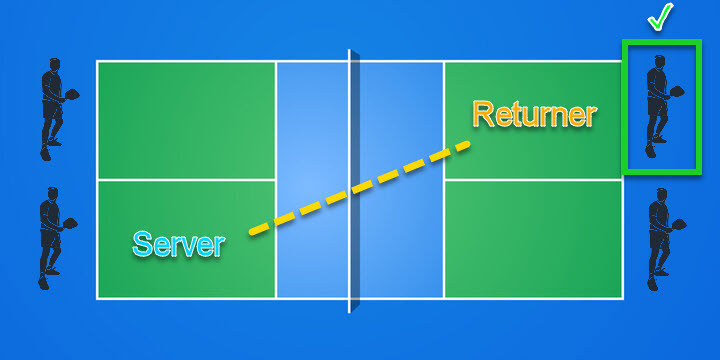
positioning for the Returner’s PArtner
And finally, to throw a fun wrench into the positioning, the person directly across from the Server on the Opposing Team (the Returner’s partner) should actually stand at the Kitchen like so:

So, ultimately, the positioning should look like this:
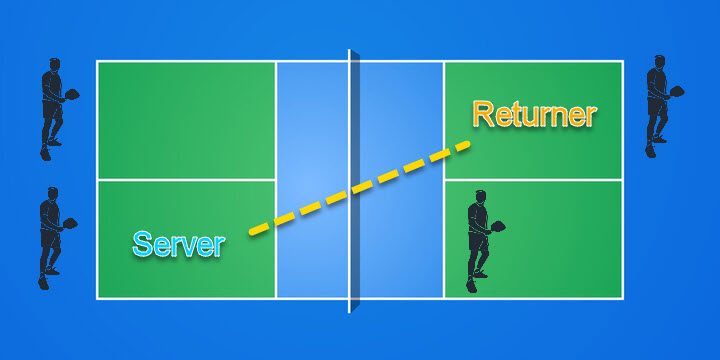
And just for reinforcement let’s look at how it might look if someone else was serving:
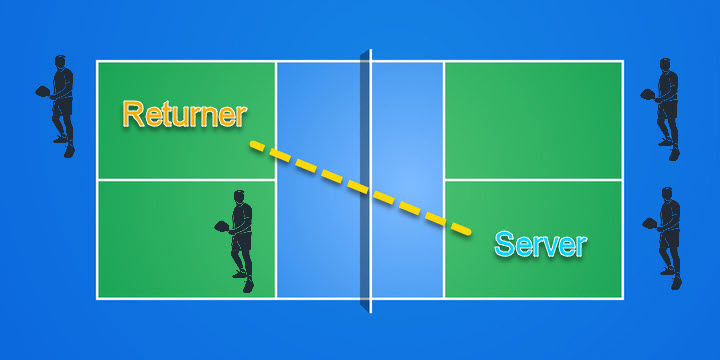
Notice that:
- 3 players are at the back line: the Server, the Server’s partner, and the Returner.
- 1 player is directly across from the Server: the Returner’s partner.
It should always be this way from a strategic standpoint:
Pickleball is played at the Kitchen. You always want to get to the Kitchen. So, if you could start there, why not? And that’s why the Opposing Player directly across from the server should always be at the Kitchen because it’s “free” for them essentially.
The rules of Pickleball prevent the other 3 players from starting at the Kitchen:
- The Server can’t start at the Kitchen because he has to Serve behind the line.
- The Server’s teammate can start at the Kitchen if he wants but because of the “Double Bounce” rule (more on this in a bit) he has to stay in the back if he wants any chance of winning the point.
- And just like the Server’s teammate, if the Returner wants any chance of winning the point, because of the “Double Bounce” rule (again, more on this in a bit) he needs to stay in the back as well.
So, if you’re the Opposing Player directly across from the server, start at the Kitchen. It’s free!
Advanced: Legal Serve
There are rules to how you can serve in Pickleball. Your serve must follow these three rules:
- Your arm must be in an upward arc when striking the ball (you can’t hit it from the side or from above)
- You must make contact below your “navel” (belly button). The rules state “below the waste” but it has been confirmed this is technically the belly button.
- Your paddle head must be below the highest point of your wrist at contact. This is a fancy way of saying, “make sure the paddle doesn’t go above your wrist” essentially.
Honestly, if you just hit in an upward motion, with the ball below your belly button, you should be fine.
You don’t get multiple attempts to get the ball over like in tennis. You get one chance.
If the ball hits the net and goes over, as long as it lands in the correct rectangle (service court) you play the point like regular.
Starting the Game, the Serving Team Serves Just Once
Starting the game, the serving team that serves first can only have one person serve before alternating to the opposing team. This keeps the team from serving first from having the overwhelming advantage of getting to serve twice first. This balances out the advantage of serving first.
So, once the person serving first on the Serving Team loses a point/rally, the serve then transitions to the Opposing Team, who will serve normally with both players serving. And then the game continues normally from there in terms of who serves when.
The Person on the Right Always Serves first
We already mentioned this but it bears repeating: whether starting the game, or transitioning the serve to the Opposing Team, the person on the right always serves first, no matter who it is.
Double-Bounce Rule
There is one rule on serving that trips people up quite a bit and really takes a lot of getting used to. The infamous “Double Bounce Rule”.
The “Double Bounce Rule” is a rule unique to Pickleball that says when the Server serves, the Returner must let the ball bounce first before they hit it back (the “First Bounce”). After the Returner hits the ball back, the serving team must allow the ball to bounce again before they hit it back (the “Second Bounce”). After this though the ball is no longer required to bounce for the rest of the point/rally. You can now hit the ball whenever you please. You can let it bounce once and hit it or you can hit the ball in the air before it ever makes contact with the ground. After the first two bounces of a rally, bouncing no longer matters. As long as you don’t like the ball bounce more than once on your side of course (just like tennis).
If someone violates the Double Bounce Rule (ie the Returner doesn’t let the ball bounce before hitting it or the Serving Team doesn’t allow the ball to bounce before hitting it back) then it is a fault and is played just like hitting the ball into the net or out of bounds: you lose the rally/point.
The “Double Bounce” rule is probably the hardest rule for people to learn besides the Kitchen rule (more on this later). It will take a lot of practice for the Serving Team not to run up on the ball hit back to them by the Returner and hit it right back without letting it bounce. Be patient with yourself.
Advanced: Double Bounce Rule
The whole reason for the “Double Bounce Rule” is so that the advantage is given to the Returning Team. Pickleball is played mostly at the Kitchen in advanced play and this rule allows the Returning Team to get to the Kitchen first before the Serving Team, giving them an advantage. If the Serving Team didn’t have to let the ball bounce on the Second Bounce, the serving team could run right up to Kitchen and take the advantage, causing them to score points more often, since you can only score a point if you’re the serving team. Games would zoom by in that case. By giving the advantage to the returning team, the games have a bit more pace and play longer than they normally would (and games can go quite quick as it is already).
Tip:
When talking about hitting returns, the idea from the Returner is to hit a return as deep as possible on the server team’s side of the court to:
- Give the Returner as much time to run up to the Kitchen as possible
- Make it harder for the Serving Team to get up to the Kitchen. The further the ball is from the net, the harder it is for them to hit a shot back that allows them to get to the net.
So, you’ve gotten the beginning of the point/rally down. Let’s move toward the middle of the point/rally.
The Middle of the Point/Rally (Hitting Back & Forth)
The middle of the game is pretty simple, you’re just hitting shots back and forth at each other until someone makes a mistake (a fault).
There are honestly no real rules to be concerned with here.
After the double bounce happens from the “Double Bounce Rule” you’re good to go. Swing away until someone makes a mistake, losing the point/rally.
Now, there’s a ton of strategy in this middle portion like getting up to Kitchen, Dinking, forcing a team to pop up a ball up for a Kill, or pop up extremely high, so you can Smash on them for a finish, etc.
But as a beginner you’re not looking for strategy. You’re just looking for the rules and to have some fun, right? So, for the middle part of the rally/point, just focus on getting the ball over the net and in bounds.
Now, speaking of the rules, this is a great time to introduce the “Non-Volley Zone” or as it’s commonly referred to: “The Kitchen.”
The ball will often go into the Kitchen in the middle of point/rally so now is a good time to bring it up.
The Kitchen
The Kitchen is by far the most infamous aspect of Pickleball. It is what separates Pickleball from every other racquet sport, including tennis.
The Kitchen is the 44 foot long x 20 foot wide rectangle on either side of the net on the Pickleball court:
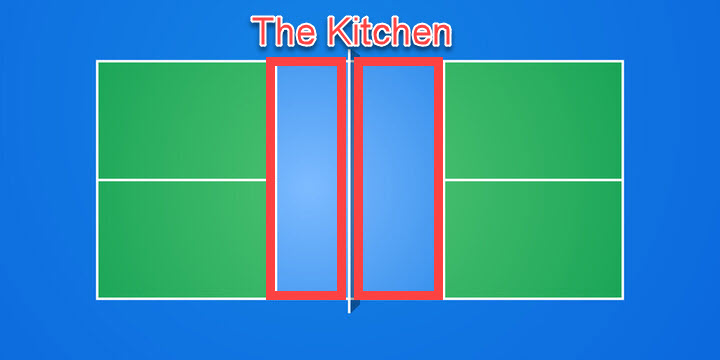
It’s purpose is to essentially prevent fire fights inches from the net where both teams just swinging away at one another for dear life. If we didn’t have the Kitchen there wouldn’t be much strategy. You’d just be walking up on each other with a race to see who can hit it the hardest and fastest.
In tennis, there’s no need for a Kitchen. If you walk up on the net in tennis the opposing team will just beat you to the right or the left. Or lob it in the back of the court because the court is much bigger. Also, a tennis ball goes much, much faster than a Pickleball so being right at the net is impractical because you won’t be able to react quick enough to the tennis ball flying over 80mph at you. If you notice, in tennis, players just naturally hang back off the net for these reasons:
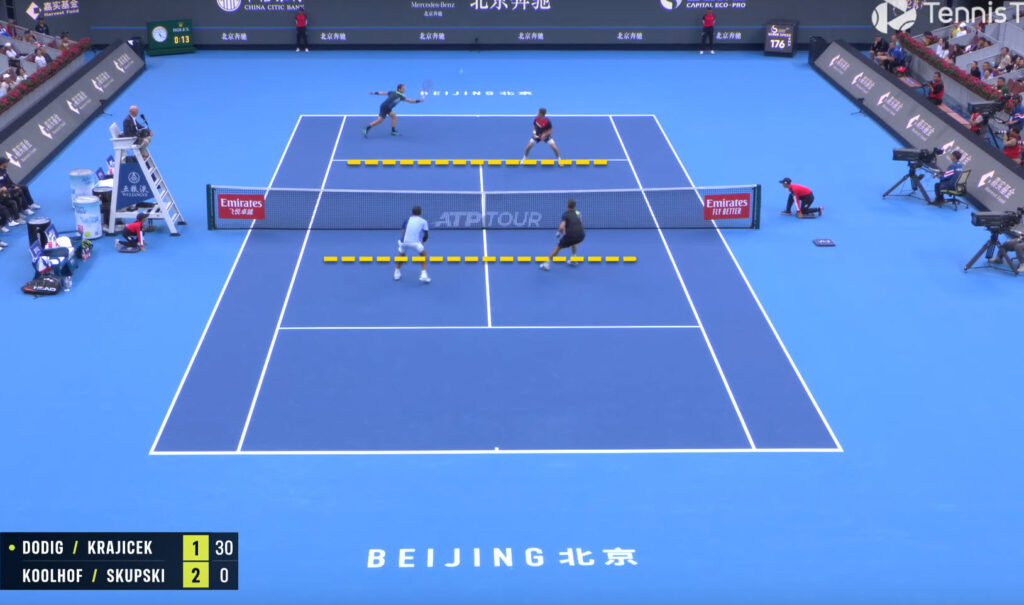
Notice my yellow line denoting the strategic space they give at the line.
However, in Pickleball, all of these negatives of being at the net are eliminated. The court is smaller so two players could cover the entire net, left to right. They can also cover lobs quite easily because of the smaller court. And the Pickleball is hit slow enough that someone at the net could theoretically return it relatively easily. All the negatives of hanging out at the net are gone in Pickleball and if players could, that’s where every good player would be.
So, Pickleball decided to enforce the space that tennis players strategically hold and they called it The Kitchen.
The Kitchen rules
The Kitchen rules are easy to learn, but also have some nuance. I’ll explain them in a very brief way that will get you started with the game and should be what you need for 99% of Pickeball games, until you get more to the intermediate level. After the simple explanation, I’ll post the “Advanced Section” with a more exhaustive explanation of the Kitchen rules, in case you’re interested.
Simple Kitchen Rules: In the beginning, when you’re just getting use to Pickleball, think of the Kitchen as a “no-go zone”. Just don’t step in there, unless…
A ball is hit in the Kitchen.
If a ball is hit in the Kitchen then not only should you feel free to walk in the Kitchen but strategically, you probably should walk in. So, walk in, hit the ball and then walk right back out after you’ve hit it.
And if you do this, you’ll handle 99% of the issues with the Kitchen.
Advanced: The Kitchen rules
Technical Kitchen Rules: The full, technical rules of the Kitchen (the “non-volley zone) are as follows:
- You can’t be in the Kitchen while volleying (a volley is a ball that is hit and does not bounce before you hit it back).
- Your momentum after hitting a volley must not carry you into the Kitchen. You must balance yourself and establish yourself outside of the Kitchen.
- Once a ball lands in the Kitchen, it is no longer a volley (again, a volley is a ball that hasn’t bounced) and you are then allowed to be in the Kitchen to hit it because it isn’t a volley.
- If you step inside the Kitchen to hit a non volley shot (a shot that has bounced) you must reestablish yourself (both feet) outside of Kitchen before you hit a volley again.
- You can technically be in the Kitchen whenever you want. But in order to hit a volley once you’ve been in the Kitchen, you must reeastablish yourself outside the Kitchen again with both feet. Making it impractical, and a strategic error, to be in the Kitchen longer than is necessary to hit a ball that has dropped into the Kitchen and then get back out again.
- The Kitchen line is a part of the Kitchen. If your foot is on the line when you hit a volley then you are in the Kitchen and it is a fault.
Pretty technical, right? If you made it this far, don’t get caught up in the complicated Kitchen rules in the beginning. Just know that you shouldn’t go in there, except to hit a shot that has landed in the Kitchen, and then just get right back out.
The “Erne”
Before we get to the end, where the point/rally is won/lost, let’s talk quickly about the “Erne”.
This skill shot, named after early pickleball player Erne Perry, is where a ball is hit over the net near one of the posts and the receiving player jumps over the kitchen, out of bounds (thus avooding being in the Kitchen and causing a violation), in order to contact the ball quicker than playing behind the kitchen will allow.
It looks like this:
Notice how when the ball is hit to him he jumps over the Kitchen, out of bounds, and then hits the ball back.
This is perfectly legal as he did not step in the Kitchen and when he contacted the ball with his paddle his paddle was on his side of the net. Had he stepped in the Kitchen or if he had hit the ball when it was on the other side the net, it would have been a fault.
And that’s an Erne.
The End of the Point/Rally (A Fault Occurs)
Now that you know how to get the point/rally started (serving) and then how to carry on the middle of the point/rally (hitting back and forth, including how to handle the Kitchen), now it’s time to discuss how the point/rally ends.
The point/rally will end basically via faults (ie going out of bounds, letting a ball bounce twice, etc.). Then the point/rally ends and a new one starts.
Faults include these basic faults:
- A ball is hit into the net
- A ball is hit out of bounds
- A player is hit with the ball (anywhere but below the wrist of the paddle hand; including catching the Pickleball when it’s a live ball, meaning a fault hasn’t occurred yet like it going out of bounds, double bouncing, etc.)
- The ball bounces twice on one side
- A player violates the Double Bounce rule
- A player violates the Kitchen (or Non-Volley Zone)
So, once a fault has occurred the point/rally is over. You now determine if a point was scored (only if the winning team of the rally/point served of course), switch serve (whether that’s the serving team switching places because they won the rally/point, or the serve transitioning to the next Server because the Opposing Team won the rally/point) and begin a new point/rally.
You will continue this until a team scores 11.
Advanced: More Advanced, Technical Faults
There are more than just the basic faults. Here are a few more random faults (that honestly, as a beginner, I would probably ignore for the moment):
- The ball hits an object like a fence, ceiling, etc.
- A player touches the net, posts, net system, or Opposing Team’s court
- A player hits the ball before it crosses the net onto their side
- A player catches or carries the Pickleball on their paddle
- A player intentionally double hits the pickleball (hits it once, waits, and hits it again; different than hitting the ball twice on accident in a single swing motion, which is allowed)
- A player calls a timeout during the rally/point
Here is a list of things that can happen that you might not expect:
- The player hitting the ball doesn’t have to be in bounds. Like in soccer, the player can be out of bounds while hitting the ball as long as the ball’s last bounce was in bounds.
- You can hit the ball around the net/post which leads me to…
Can the ball go around the net/post?
In Pickleball, the ball can actually go around the net/post, it does not have to go over. This is called an “Around The Post” or “ATP” for short and is a favorite of pickleball players.
Typically what happens is the ball is hit into the kitchen at an angle and as the ball is heading out of bounds the player chases it and right before the ball bounces twice the player hits it around the post (the ball is out of bounds, beyond the post at this point) into the Opposing Team’s court.
It’s a semi-difficult shot to pull off and a very difficult shot to defend. It usually results in a winning shot if the player hitting the shot can indeed get it around the post and into the Opposing Team’s court. Neither of those is a given.
Here’s a quick example:
Notice how the shot is hit wide into the Kitchen with enough bounce to make it travel to a spot where the player can get the angle to hit it into the Opposing Team’s court.
That’s an ATP and is perfectly legal.
Scoring
Games in Pickleball are played to 11.
A team scores a point only if they do both of the following:
- Win the rally/point
- Served that rally/point
The technical term for this type of scoring where you have to serve to get a point is “side-out” scoring. But who cares, 99% of Pickleball is played this way and you don’t need to know that term honestly. Just remember you can’t get a point unless you served.
What this means though is that the non-serving team can never win a point. Only the serving team can. The non-serving team must make the serving team lose their rally/point and then become the serving team themselves. THEN they can start to win points as the serving team.
So, scoring is pretty basic: you play to 11 with only the serving team able to win a point at the end of the point/rally.
The only exception to playing to 11 is the “Win By 2” rule…
Win by 2
For those unfamiliar with “win by 2” scoring, the winning team can’t win by 1. They have to win by 2 or more. So, if the score is 10-10 and a team wins a point to get to 11, making the score 11-10, the game is still not over even though the score is 11-10 and a team has reached 11. The team at 11 must reach 12 to make the score 12-10 to “win by 2”.
But let’s say the team that scored 11 to make the score 11-10 allowed a point from the other team to make it 11-11. Now the winning score has to be 11-13. If it’s 12-12 the winning score is now 14 and so on and so forth.
The easiest way to think about it is that you cannot win by 1 point in Pickleball. You must win by 2 and the game & score will continue until someone does win by 2.
Calling the score
In Pickleball, it’s important to call the score before each serve.
The serving team always calls their score first, followed by the opponents score second, and then finally whose serve it is.
So if the score is 7 to 8, with the serving team’s score being 7, and the 2nd person is serving, you would call out “7-8-2”.
If the score was 11 to 3, with the opponent’s score being 11, and the 1st person serving, you would call out “3-11-1”.
So, you always call out “serving team score – opponent’s score – position of person serving”.
Advanced: A Note on Rally Scoring
It’s not worth mentioning too much in a beginner article but just for your education:
Rally scoring is starting to be tinkered with in Pickleball. MLP (Major League Pickleball), a bit of a start up in the Pickleball world, has moved to rally scoring to try to make the game more exciting (in their opinion).
Rally scoring is where you don’t have to serve to score a point on a point/rally. No matter who serves, someone is going to score a point. Games are played to 21 in this case.
Just for your edification.
Conclusion
And that’s it!
Now you know how to play Pickleball from beginning to end.
But don’t concentrate too much on the nitty gritty of the rules.
Just get the ball over the net and have a good time!



Leave a Reply